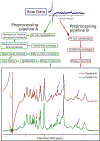Preprocessing, analysis and quantification in single-voxel magnetic resonance spectroscopy: experts' consensus recommendations
- PMID: 32084297
- PMCID: PMC7442593
- DOI: 10.1002/nbm.4257
Preprocessing, analysis and quantification in single-voxel magnetic resonance spectroscopy: experts' consensus recommendations
Abstract
Once an MRS dataset has been acquired, several important steps must be taken to obtain the desired metabolite concentration measures. First, the data must be preprocessed to prepare them for analysis. Next, the intensity of the metabolite signal(s) of interest must be estimated. Finally, the measured metabolite signal intensities must be converted into scaled concentration units employing a quantitative reference signal to allow meaningful interpretation. In this paper, we review these three main steps in the post-acquisition workflow of a single-voxel MRS experiment (preprocessing, analysis and quantification) and provide recommendations for best practices at each step.
Keywords: MRS; analysis; preprocessing; processing; quantification; quantitation; water referencing.
© 2020 John Wiley & Sons, Ltd.
Figures






References
-
- Klose U In vivo proton spectroscopy in presence of eddy currents. Magn Reson Med 1990;14:26–30. - PubMed
-
- de Graaf AA, van Dijk JE, Bovee WM. QUALITY: quantification improvement by converting lineshapes to the Lorentzian type. Magn Reson Med 1990;13:343–57. - PubMed
-
- Bartha R, Drost DJ, Menon RS, Williamson PC. Spectroscopic lineshape correction by QUECC: combined QUALITY deconvolution and eddy current correction. Magn Reson Med 2000;44:641–5. - PubMed
Publication types
MeSH terms
Substances
Grants and funding
LinkOut - more resources
Full Text Sources

